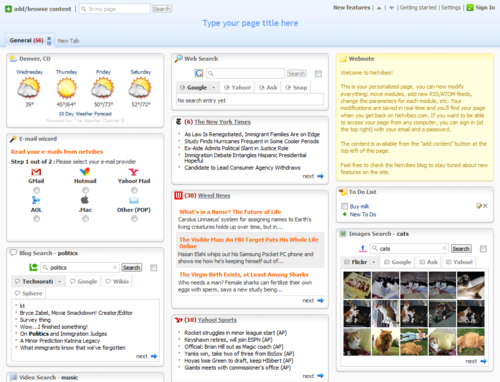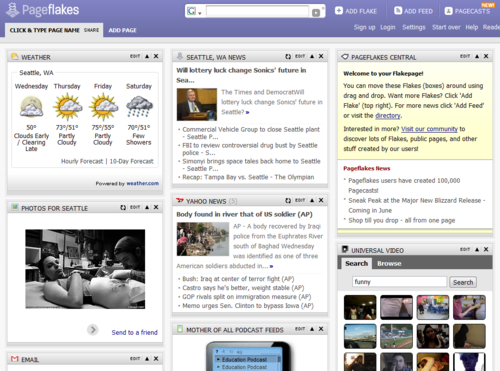Easing visitors into a site with anonymous accounts
For while now I’ve been trying Netvibes and Pageflakes, two members of a new school of sites that invert the traditional service signup experience. As discussed in the last post, old school sites put up numerous marketing, signup, and technology-related hurdles at the entrance to their service. New school sites like Netvibes and Pageflakes turn this experience on its head: first the visitor tries the product using something tantamount to an anonymous account. Once the visitor is convinced they like the service and want to get more out of the service—only then do they complete the steps to form a relationship with the service.
Both Netvibes and Pageflakes let users build and edit a highly customizable home page. Such home pages have existed for years, but in the past customizations were generally available only to users with established accounts. These two sites, in contrast, take a new visitor straight to their very own customizable home page. In Netvibes, for example, a small portion of the page explains what the service does, but most of the page is given over to functional widgets that demonstrate the service with real examples:

The general idea is that the user will figure out what the product is by using the product itself—not by reading marketing verbiage or sitting through a demo. The page reveals customization capabilities through a combination of self-explanatory elements ("Type your page title here") and additional options revealed on hover.
PageFlakes is very similar to Netvibes. Pageflakes does almost as good a job as Netvibes in welcoming visitors to their product, although for some reason they feel compelled to display a welcome page first. In using both sites, PageFlakes seems to be slightly more polished than Netvibes (though I personally wouldn’t have attempted to build a brand around the word "flake").

These sites both use cookies to establish a tentative, anonymous relationship between you and the site. You can even enter personal data to customize the various widgets, but until you’ve established an account, you’re generally using the service anonymously. (Of course, even without a user ID, each additional piece of data you enter to customize the site can be used to more precisely identify you.)
You can use your anonymous account for as long as you want to, provided you use the same browser on the same machine to do so. Whenever you reach that point—maybe even months after starting to use the service—you can sign up for an account. The basis of your relationship with the site transfers from your anonymous browser cookie to a real account secured with a user ID and a password. (Both these sites use your email address as a user ID, to eliminate the signup hurdle of picking a user ID.)
The deep principle at work is that a site doesn’t need to rush to secure a relationship with a visitor. Inevitable interest in getting more out of the site (in these cases, the desire to use your customized home page from another location) slowly pushes you, the casual anonymous visitor, to finally forge a permanent relationship with the site as an identified user. The site knows a relationship with you will develop in its own time.
I’ve been searching for a compelling real-world analogy to this kind of anonymous trial-before-signup experience. The best I’ve come up with so far: a public library. Anyone can walk in off the street and participate in a highly useful basic level of service—just pick a book off the shelves and start reading. You can do this for as long as they want, and you don’t need to supply identification to do so. However, when you eventually want to take a book home, you must "upgrade" to a higher level of service. You must establish an account with the library, and this step requires that you identify yourself (with, for example, a document showing your address).
I still have yet to establish a full account with either Netvibes or Pageflakes, but have continued to try both out anonymously. I might never elect to sign up with either service. Yet, even if I eventually abandon them, I will have used each far longer than I ever would have if it had made me sign up first.